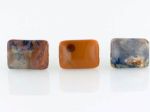|
Agate |
Agate is a vibrantly colorful, often banded variety of Chalcedony Quartz. It was discovered sometime between 400 and 300 BC by a Greek Philosopher named Theophrastus. It often occurs in volcanic rocks and ancient lava flows. A petrified wood variant of Agate is found in abundance in Arizona. Fire Agate (Orange) represents the Sacral Chakra it is positioned at the center of the abdomen which rules the reproductive system. Agate balances the yin-yang energy bringing a sense of courage. It cleanses and stabilizes your aura balancing the physical, emotional, and intellectual bodies with the spiritual. Agate is a birthstone for May/Gemini. Mohs' Hardness Scale: 6.5-7 |
Amazonite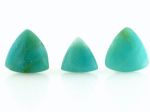 Shop Amazonite |
Amazonite is sometimes confused with Chrysoprase, Serpentine, Jade or Turquoise. This stone is sensitive to pressure and has an irregular color distribution. Its bold color is due to the presence of lead. Amazonite (Blue/Green) represents the Throat and Heart Chakras, however it is soothing for all the Chakras. Amazonite soothes the nervous system, while giving strength to the heart and body, balancing the mental and Auric Body. Amazonite resonates with the Astrological Sign: Virgo. Mohs' Hardness Scale: 6-6.5 |
Amethyst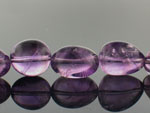 Shop Amethyst |
Amethyst is the February/Aquarius birthstone. It is known for spiritual upliftment and helpful in communicating effectively. In ancient times, amethyst was thought to have numerous mystical and protective powers. It is the most highly valued of the quartz varieties and is typically found in a lilac to deep purple coloring. These beautiful nuggets are a great enhancement to any design.Amethyst (Violet/Purple) represents the Crown Chakra which is positioned at the top of the head, aiding in spiritual upliftment. Amethyst helps clear the aura, while balancing the physical, intellectual, and emotional bodies. Amethyst is the February/Aquarius birthstone. Mohs' Hardness Scale: 7 |
Ametrine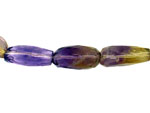 Shop Ametrine |
Ametrine is a mixture of both Amethyst and Citrine. Deposits are found in Brazil an Bolivia. This gorgeous stone combines two colors that you don't see together too often. Mohs' Hardness Scale: 7 |
Apatite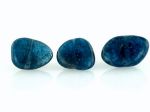 Shop Apatite |
The word Apatite in Greek means "cheat". It was originally named this way because this stone can so easily be confused with amblygonite, andalusite, brazilianite, precious beryl, sphene, topaz and tourmaline. As this is a fairly soft stone, it can be difficult to facet. Mohs' Hardness Scale: 5 |
Aquamarine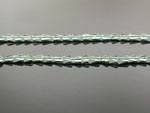 Shop Aquamarine |
Aquamarine is named for it's seawater color. Dark blue is the most desired color. This popular stone needs to be handled with care; it can be brittle or sensitive to pressure. However, the beauty of this stone makes the time spent maintaining it seem unimportant. Mohs' Hardness Scale: 7.5-8 |
Aventurine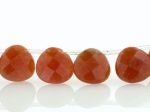 Shop Aventurine |
Aventurine is said to be a good luck stone, especially in financial matters. It is supposed to stimulate creativity, intelligence and perception, while giving the wearer a sense of mental and emotional well-being. It was discovered by chance around 1700. |
Beryl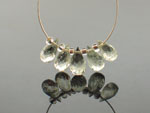 Shop Beryl |
Beryl has vitreous luster that will sometimes cause a "cat's eye" effect. There are many different types of Beryl. For instance, aquamarine, emeralds and morganite are all considered a part of the Beryl family as they are all composed of Beryllium Aluminum Silicate. Mohs' Hardness Scale:7.5-8 |
Bronzite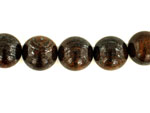 Shop Bronzite |
Bronzite is from Montana, USA. It is rich in iron with a metallic luster. |
Calcite Shop Calcite |
Calcite, in it's true form, is colorless. However, it is dyed or heat treated to become many different colors. It is the principle component of limestones and marbles. Mohs' Hardness Scale: 3 |
Carnelian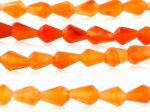 Shop Carnelian |
Carnelian is an orange variety of Chalcedony. It is assumed to have received the name Carnelian from the kornel cherry, due to the similar color. Carnelian was once thought to still the blood and calm the temper. Carnelian (Orange) represents the Sacral Chakra it is positioned at the center of the abdomen which rules the reproductive system. Carnelian can help you deal with depression and sorrow in times of need. Carnelian is a birthstone for July and August. Mohs' Hardness Scale: 7 |
Chalcedony Shop Chalcedony |
Chalcedony is thought to have been named after an ancient town. In ancient times it was used for cameos. This chalcedony is all natural and has not been dyed or heat treated. |
Chromium Diopside Shop Chromium Diopside |
Chromium Diopside is one of those rare gemstones whose history has truly just begun. The world first heard about chrome diopside in 1988 when rumors of a stunning green gem emerged out of northern Siberia. Chrome diopside has rich vibrant greens that rival the beauty of emerald. Chrome diopside color variations range from a vivid, bright green to a dark green that appears almost black. Color is natural and caused by the presence of chromium. Mohs' Hardness Scale: 5.5-6 |
Chrysocolla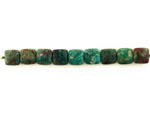 Shop Chrysocolla |
The ancient Greeks referred to artificial preparations used in a flux in soldering of gold as "chryso kolla", meaning "gold glue". This somehow became the name of this blue-green stone, Chyrsocolla. Mohs' Hardness Scale: 2-4 |
Chrysoprase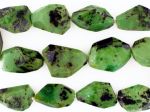 Shop Chrysoprase |
Chrysoprase is considered the most valuable stone in the chalcedony group. It has been used for interior decoration in the Wenceslaus Chapel in Prague and in Sanssouci Castle New Berlin. Mohs' Hardness Scale: 6.5-7 |
Citrine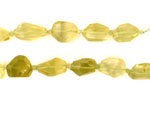 Shop Citrine |
Natural Citrine is rare and is mostly pale yellow. The name is derived from the word, "citrus". Citrineis a macrocrystalline variety of the mineral Quartz. The color is due to small amounts of iron impurities. Stable in light and not very sensitive to chemicals, this stone requires no special care and can be used for any jewelry application. Virtually all Citrinecomes from Brazil.Citrine(Yellow) represents the Solar Plexus Chakra which is positioned above the abdomen but under the rib cage. Citrine is uplifting it helps raise self-esteem. Citrine is one of the birthstones for November. Mohs' Hardness Scale: 7 |
Diamond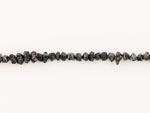 Shop Diamonds |
Diamonds are an elegant jack of all trades. They functioned as cutting and engraving tools for early man. They serve contemporary scientists with their ability to slow light. They have been cherished in religious icons and their wide spectrum of colors has been used for adornment for thousands of years.Black Diamond (Black) is helpful in grounding ones energy. Diamond dispels negativity, while purifying the body bringing serenity to the mind, body and spirit. Diamond is the Birthstone for April. Mohs' Hardness Scale: 10 |
Emerald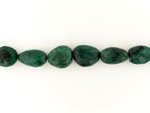 Shop Emerald |
Emeralds are the most precious stone in the beryl group. However, they are rarely flawless.Emerald is said to give confidence, peace and harmony and to enhance one's creativity and mental capacities. It is also said to instill and nurture mutual love and loyalty in marriage, and to ensure honesty and success in business dealings and other relationships.Emerald is also said to help strengthen and heal the heart and kidneys, and to help remedy circulatory and neurological disorders and eye irritations, and to help eliminate free radicals from the body. Mohs' Hardness Scale: 7.5-8 |
Fluorite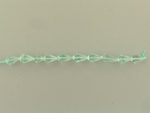 Shop Flourite |
Fluorite has a long standing history. Though it is relatively soft, it was used by ancient Egyptians in statues and to carve scarabs. The Chinese have used it in carvings for over 300 years. And, Fluorite was powdered in water to relieve the symptoms of kidney disease. Fluorite is said to enhance intuition, creativity, concentration and one's sense of order. It is also said to promote healing, and to facilitate healing work being done with other minerals, and to give protection against many types of diseases. It is also said to help release negative thoughts, and to give protection against them. Mohs' Hardness Scale: 4 |
Garnet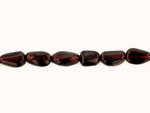 Shop Garnet |
The Garnet is one of the earliest stones to attract human attention and has been found all over Europe, Asia, and the Americas in graves and shrines. Garnets have a rich history, full of interesting trivia. In the Middle ages, they were prescribed to cure any illness that was associated with redness (since the stone is typically a deep purple red) ... Such as, blood disorders, anger, fever, etc.Tourmalinated Green Garnet (Green) represents the Heart Chakra which is positioned at the center of the chest. Garnet helps to develop love and compassion, it brings a protective and calming energy, balancing emotional disharmony. Black Tourmaline repels and protects you against negativity. Garnet is the January/Aquarius Birthstone. Mohs' Hardness Scale: 6.5-7.5 |
Gaspeite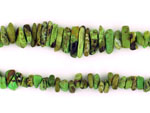 Shop Gaspeite |
Gaspeite is a rare Nickel Carbonate mineral. It's apple green color is a great complement for stones such as Turquoise, Onyx or Coral. Gaspeite takes it's name from the locality where it was first discovered - Gaspé Peninsula, Quebec, Canada.Gaspeite (Green) represents the Heart Chakra which is positioned at the center of the chest. Gaspeite can help reduce stress, and bring spirituality into everyday life. |
Goldstone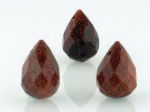 Shop Goldstone |
Goldstone is man made. Some speculate it was discovered by accident when alchemists were trying to create man made gold. Goldstone is created of brown glass with copper oxide added. It is heated to a high temperature and when it cools the oxide changes into beautiful crystals that sparkle through the brown glass. It is said to reduce tension and stomach problems. |
Hypersthene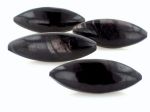 Shop Hypersthene |
Hypersthene is optically stunning. It shimmers and shines a beautiful black silver color that is sure to catch your eye. This stone is found in India, Norway, Greenland, Germany and the USA. It is a collector's stone and can tend to be brittle. |
Iolite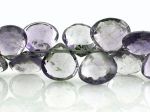 Shop Iolite |
Iolite has also been called water sapphire because it can be very similar to blue sapphire when cut. |
Jade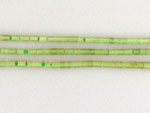 Shop Jade |
Jade is a truly iconic gemstone. One of a small handful of gemstones that can be identified by people that know almost nothing about gemstones. It has been used as a decorative stone for jewelry, statues, kitchenware and tile. It has been edged and polished and made into weapons and tools. Jade has been used as a sared burial stone and even made into exotic suits for departed royalty. |
Jasper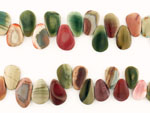 Shop Jasper |
The name Jasper means "spotted stone". Jasper is multi-colored and fun to work with because each bead is like a snowflake, unique. It is supposed to calm a troubled mind and help with digestive problems. |
Jet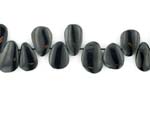 Shop Jet |
Jet has a luminous, waxy luster. It is a coal that can be polished that has been used over time for mourning jewelry, rosaries, ornamental objects and cameos. |
Kunzite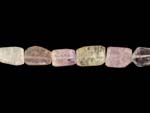 Shop Kunzite |
Kunzite is named for a U.S. Minerologist, G.F. Kunz. It is a gem variety of Spodumene that is available in an array of pastel colors: lilac, soft pink and yellow. |
Kyanite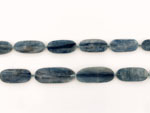 Shop Kyanite |
Kyanite means "blue" in Greek. This stone is gem quality and is by far one of our favorites. |
Labradorite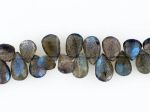 Shop Labradorite |
Labradorite is named after the Peninsula of Labrador in Canada where it was first found. This stone will make any design stand out with it's shimmer and shine. |
Lapis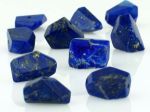 Shop Lapis |
Lapis is an intense blue stone, peppered with flecks of golden pyrite. It has been treasured throughout history and has been unearthed in ancient Egyptian tombs. Decorate your next design with the prize of poets and kings. |
Larimar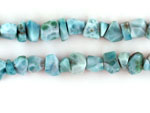 Shop Larimar |
Larimar is a rare stone found only in the Dominican Republic. It has the watery sheen of the sea. Discovered in the early part of last century, the stone did not really find its welcome until rediscovery in the seventies. |
Maw Sit Sit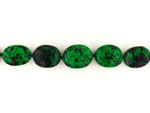 Shop Maw Sit Sit |
Maw-Sit-Sit is a fun way to add glimmer to a green design. It gets its wonderful luster from its rich chromimum content. Add a deep Jade blush to your next necklace. |
Moonstone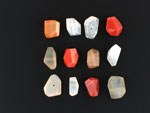 Shop Moonstone |
Moonstone receives it's name from the moon. It has a glow about it that is unlike any other stone. Moon worshippers through the ages have used this design in their jewelry. |
Morganite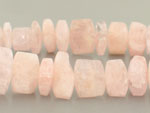 Shop Morganite |
This stone is named after the American banker and collector J.P. Morgan. It is in the Beryl family along with Emeralds and Aquamarine. |
Moukaite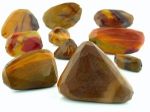 Shop Moukaite |
Moukaite comes from Australia. It is sometimes called the "Outback Jasper". It typically has bands of all sorts of colors from pinks to yellows to deep reds. This stone is unique and a lot of fun to design interesting jewelry.Moukaite Jasper (Pink/Yellow/Red) represents the Heart, Solar Plexus, and Root Chakras. Jasper protects you against negativity and is also an excellent grounding stone spiritually and emotionally. Jasper is the birthstone for March. |
Obsidian Shop Obsidian |
Obsidian is a natural glass. It is formed from volcanic lava that has cooled too quickly. It has been used since prehistoric times to make tools, weapons, masks, mirrors and jewelry. These beautiful nuggets are a great enhancement to any design. Obsidian (Black) works with the Root Chakra which is positioned at the base of the spine, helping in grounding ones energy. Obsidian aides in clearing subconscious blocks bringing an experience of understanding. |
Onyx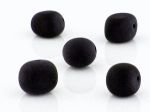 Shop Onyx |
Onyx, as a name, has it's origin in Greek meaning "fingernail". This is probably because of it's weak transparency. This stone is usually banded whites, blacks and grays. Most onyx is dyed a solid color. |
Opal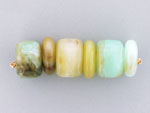 Shop Opal |
The word Opal is derived from an Indian word meaning "stone". There are 3 subgroups with properties that vary considerably. Peruvian Opal is a gorgeous mixture of milky whites, greens and browns. The variations of color from shades of white to dark gray make African Opals distinctively stand out. Mexican Fire Opals are a nice mixture of oranges and reds. Pink Opals are one of the hottest stones on the market today! |
Pearls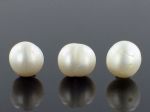 Shop Pearls |
Pearls are organic gem stones. They are formed when a foreign body, grain of sand or parasite, becomes trapped inside of the shell of a mollusk. Mother of Pearl is the hard, pearly layer on the inside of pearl oysters and seashells. |
Peridot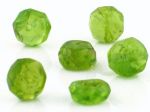 Shop Peridot |
The name Peridot is thought to have been derived from the word "faridot", gem in Arabic. It was the most popular during the Baroque Period. The largest Peridot weighs 319 cts. And, is now located at the Smithsonian in Washington D.C. Our Peridots are not quite that large, but they are high quality and absolutely a gorgeous addition to any beader`s collection. Peridot is the birthstone for August. |
Pietersite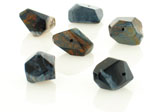 Shop Pietersite |
Pietersite is named for the man that discovered it. It is mined in Africa and China. It has a wonderful, earthy canvas and can be used in a diverse collection of designs. Its color is equally masculine and feminine and can be used for jewelry for either gender. |
Prehnite 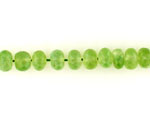 Shop Prehnite |
Prehnite is named after the Dutch Colonel von Prehn who first introduced this stone to Europe. Some prehnite is fibrous enough to show a cat's eye effect. |
Quartz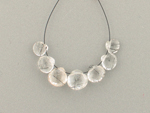 Shop Quartz |
Quartz is one of the most abundant minerals and comes in many variations. It is named for the Slavic word that means "hard". This stone is said to balance creativity and mental processes. These beautiful nuggets are a great enhancement to any design. Clear Quartz (Clear/White) represents Purity. |
Sapphire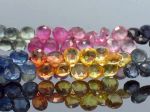 Shop Sapphire |
The name Sapphire in Greek means-blue. At first only the blue variety was recognized as sapphire. Now, various colors are qualified by descriptions. I.E. Green Sapphire or Yellow Sapphire. The hardness is the same as that of a Ruby. Sapphire is a birthstone for April/Taurus. |
Septarian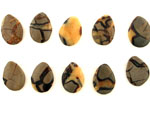 Shop Septarian |
Septarian is a concretion created by ancient volcanoes. Septarian is comprised of a mixture of stone and mineral: calcite, limestone, baronite, or aragonite. The pattern on each stone is wildly different with broken lines and random zigs - no two stones are alike. Septarian is an earthy stone that would like great on a masculine or feminine design. |
Seraphinite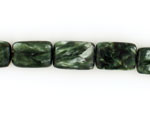 Shop Seraphinite |
The name Seraphinite is derived from the Latin word "seraphin" which refers to the first order of angels. Silvery Mica runs throughout this stone, creating patterns that look like feathery angel wings. Much like Charoite, Seraphinite has a fantastic sheen from the Mica inclusions. This beautiful stone is mainly found in eastern Siberia, Russia. |
Serpentine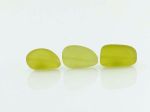 Shop Serpentine |
Serpentine takes it's name from the speckled and scaly appearance of the stone. This stone shares some of the same properties of Jade and is sometimes used in place of Jade in designs. These beautiful nuggets are a great enhancement to any design. |
Sodalite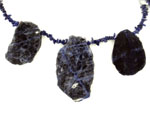 Shop Sodalite |
Sodalite is a deep ocean blue mineral similar in appearance to Lapis. It was discovered in 1806, in Greenland. It takes it's name from two Greek words meaning salt and stone, this name is derived from it's high sodium content.Sodalite is sometimes called Princess Blue, after Princess Patricia of Connaught, who used the stone for interior decoration. |
Spinel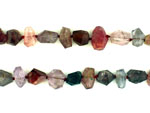 Shop Spinel |
Spinel is a vibrantly colored mineral that has historically been used in place of rubies. Its luster and appearance are similar enough to rubies that they have often been mistaken as such. Spinel has found its way onto the crowns and battle helmets of kings and queens. Spinel has quietly made a name for itself under the shadow of the more expensive ruby. Its durability and wonderful spectrum of vivid color lends itself to any beautiful design. |
Sugilite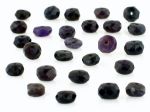 Shop Sugilite |
Sugilite or Luvulite was discovered in the forties. It has a nice array of pink and purple tones with splashes of white and black highlights. |
Sunstone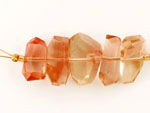 Shop Sunstone |
Sunstone is also known by the name Aventurine Feldspar. This name is derived from the Italian "a ventura" which is a type of glass that was discovered by chance around 1700. |
Tanzanite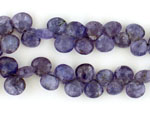 Shop Tanzanite |
The name Tanzanite is after the East African state of Tanzania where the stone is currently mined. This stone is gorgeous, rare and was described by Henry Platt, a former vice-president of Tiffany, as the most exciting gemstone find of the 20th Century. |
Tektite Shop Tektite |
Tektites are an otherwordly addition to any bead collection. The intense heat and pressure required to create these gems suggest the process occured outside of our tiny blue planet. Another theory is that they were created by a meteorite impact. |
Topaz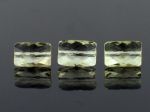 Shop Topaz |
The name Topaz is thought to have been derived from an island in the Red Sea, formerly known as Topazos. This stone comes in a variety of colors. |
Tourmaline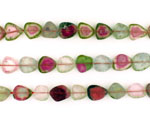 Shop Tourmaline |
Tourmaline is a fun gemstone that comes in a wide spectrum of colors, ranging from black to bubble gum pink and minty green. Tourmaline will give any design an electric blast of color.Tourmaline (Multi Color) can represent all the Chakras. In its many colors it offers a strong protective influence, enhancing self-confidence, sensitivity and comprehension by dispelling fear and negativity. It is a great balancing gemstone for our physical, emotional, and spiritual bodies. Tourmaline (Pink) is the birthstone for October. |
Turquoise Shop Turquoise |
Turquoise is the December/Sagittarius birthstone. Both turquoise and turkey (that great holiday bird) are derived from the country that first introduced both to Europe, Turkey! However, Turquoise is found all over the world. It has been important to Native American heritage. Their intricate, hand made jewelry has extraordinary craftsmanship that often incorporates Turquoise. It can be found in varying colors of blue and green. |
What Attributes Make a Gemstone Desirable?
It's worthwhile to ask what qualities are desirable in a gemstone. There are six main characteristics which are classically regarded as being desirable in a gemstone. These are in order of importance: Beauty, Durability, Rarity, Fashion, Special Properties, Individual Taste
Beauty
First, a gemstone should be optically attractive. It can achieve this in various ways. It could be a beautiful color, or it could sparkle through reflecting light. All the aspects of beauty relate to what happens to light when it hits the gemstone.
Color
The most important gem characteristic is color. Gems such as ruby, amethyst, sapphire and emerald have beautiful color as their main attraction and are generally expected to be transparent. However it is not necessary for a gemstone to be transparent. Coral, lapis lazuli, carnelian and opal are beautiful but are usually opaque. Although sapphire, spinel and quartz can occur in colorless varieties, they can be uninteresting because they do not have the advantage of possessing the beauty of color. Diamond likewise is often colorless, but it is considered by many to be the most desirable gemstone. The main reason why diamond is suitable as a gemstone is its high refraction and dispersion - now we are getting technical! If you want to deepen the color of your gemstones, you should check out our wide selection of colors in Soft Flex Wire .019.
Sparkle
Why some stones sparkle more than others: Reflection, Refraction, Dispersion, Faceting
Reflection: All stones will reflect light from their surface. The amount of light reflected will depend on the surface reflectivity of the stone. The reflectivity of a stone at its surface is often referred to as its luster. Transparent stones will also reflect light from their internal surfaces. The proportion of light reflected off an internal surface increases suddenly at a particular angle known as the angle of total internal reflection. This angle is very important when determining the best cutting angles for a gemstone.
Refraction: All materials refract light, meaning alter the light’s angle. The amount by which light is refracted is an important feature of every gemstone. The measure of a material's refractivity is known as its refractive index (R.I.).
Dispersion: Dispersion is the difference between the amount of refraction of different colors of light. White light is actually composed of light of all different colors. A highly dispersive material will split light strongly into component colors to give a "prism" effect showing a rainbow or spectrum. Diamonds owe most of their beauty to their high dispersion.
Faceting: The number of facets on a gemstone and their careful placement will give a stone more sparkle. Good faceting can enhance the beauty and desirability of the gemstone.
Size
In general a larger gemstone has more obvious beauty.
Shape
To some, a heart shaped stone may be more desirable than a different shape, but this is usually a matter of personal preference. Some stones naturally occur in certain typical shapes, or lend themselves to be cut in certain shapes. Emeralds for example lend themselves to being cut into oblong or octagonal shapes, so that an oblong shape with its corners cut to form an octagon is known as an emerald cut.
Durability
Regardless of how beautiful a stone may appear, for it to be suitable as a gemstone, it will need to be reasonably durable. Gemstones do vary considerably in their durability, some, such as diamond, are almost indestructible, others are considerably more delicate.
Hardness
There are numerous different ways of considering hardness, but the main one for gems is their resistance to abrasion. Moh's hardness scale lists 10 well known minerals on a scale from 1 to 10. Each numbered mineral will scratch the mineral numbered below it.
Rarity
Many state that rarity is necessary or desirable for a gemstone. We believe that a beautiful and attractive gemstone is just as beautiful and just as attractive whether it is common or rare. Supply and demand usually dictate that rare objects command high prices. Only the status value of gems is increased by their rarity, not their aesthetic value.
Natural, Synthetic or Simulant?
Many insist that being natural is a necessary attribute for a gemstone. Certainly, ownership of a rare, expensive and all natural gemstone gives the owner a degree of status and personal satisfaction. However, this does not make a beautiful, attractive synthetic or simulated gem any less beautiful. There is a difference between natural, synthetic, and simulated. A gem simulation is a stone which appears similar or identical to a different stone. Cubic zirconia can be used to imitate or simulate a diamond. A synthetically produced diamond is a real diamond that is man made, not a simulation for diamond. Synthetic gemstones are relatively recent.
Fashion
Fashion can play a part in determining whether a gemstone is popular. There are many stones that have historically had no claim to fame until a famous person was photographed wearing it or a big name designer decided to use it as a part of their new fashion extravaganza.
Special Properties
Special properties include possible health or social effects which gemstones can possess. This includes the categories of superstition, religion, social custom and health.
Health: It has long been believed that wearing certain minerals and gemstones can create beneficial health effects.
Superstition: Superstition sometimes plays a part in choosing a stone. For instance, some people believe emeralds or opals are unlucky or that "pearls are for tears".
Religion: Beads and gemstones have long been used for religious ornamentation or for prayer and worship. For example, bishops wear large stone rings as a symbol of their office usually with red or purple stones. Similarly, red stones may be set in a cross or crucifix.
Social Customs: In some societies and cultures wearing gemstones may convey a message about the social status of the wearer.

